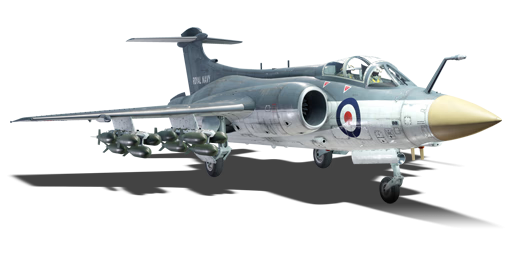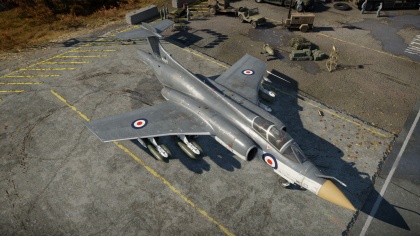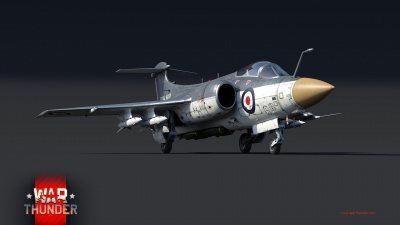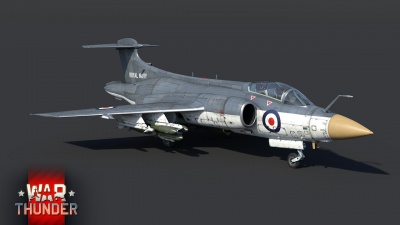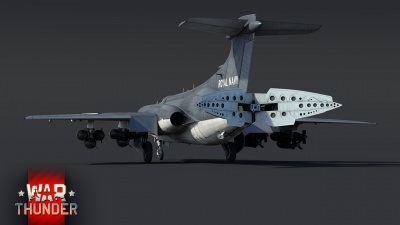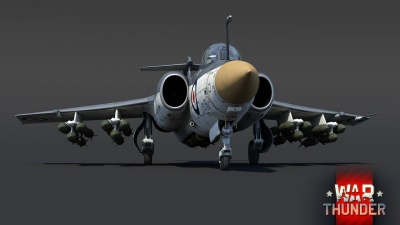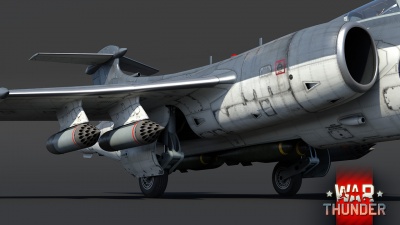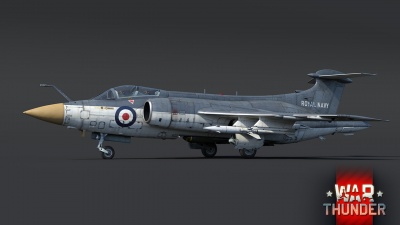Buccaneer S.2
Contents
Description
The Buccaneer S.2 is a rank VI British jet attacker
with a battle rating of 10.3 (AB) and 9.3 (RB/SB). It was introduced in Update "Hot Tracks".
General info
Flight performance
Despite being the heaviest, longest and biggest jet bomber in the game, the Buccaneer has an impressive cruise speed, manoeuvrability and climb rate even when fully loaded. It should be noted that it is nowhere near on being the fastest plane at its battle rating but can become a forceful opponent when being hunted down, especially if the Buccaneer has a speed advantage. Despite having a max speed of 1,084 km/h, the aircraft is able to reach that speed even when fully loaded flying at level flight. It is able to surpass the max speed at level flight up to 1,112 km/h but any sudden turn will tear apart the wings. Overall agility of the Buccaneer is impressive for a plane of its size capable of doing hard turns with relative ease even with payload.
When on take-off:
The Buccaneer MUST use take-off flaps in order to achieve enough air lift to lift the plane at ~270 km/h and do a safe take-off fully loaded with 16k lb of bombs. Not doing so may be cause of running out of airstrip before taking off and crashing into buildings or environment. When taking off from carriers, there is no need to use take-off flaps but it is recommended as it is prompt to lose altitude when leaving the deck.
When on landing:
Landings should be done below 400 km/h but depending on the situation, map and place where the Buccaneer will land (aircraft carrier or airfield) this may vary. When landing on a carrier, maintain greater speeds than 360 km/h but less than 400 km/h, this is to ensure a safe pull up if the hook is missed. When landing on airfield, maintain greater speeds than 280 km/h but less than 360 km/h, this is to ensure the plane has enough strip to break and slowdown. Thanks to being a massive plane, the momentum is tremendous, meaning it will require longer distances in order to fully land. Use air-break in order to make a faster slowdown.
| Characteristics | Max Speed (km/h at 0 m - sea level) |
Max altitude (metres) |
Turn time (seconds) |
Rate of climb (metres/second) |
Take-off run (metres) | |||
|---|---|---|---|---|---|---|---|---|
| AB | RB | AB | RB | AB | RB | |||
| Stock | 1,090 | 1,084 | 15000 | 32.7 | 34.3 | 37.1 | 30.7 | 900 |
| Upgraded | ___ | ___ | __._ | __._ | __._ | __._ | ||
Details
| Features | |||||
|---|---|---|---|---|---|
| Combat flaps | Take-off flaps | Landing flaps | Air brakes | Arrestor gear | Drogue chute |
| ✓ | ✓ | ✓ | ✓ | ✓ | X |
| Limits | ||||||
|---|---|---|---|---|---|---|
| Wings (km/h) | Gear (km/h) | Flaps (km/h) | Max Static G | |||
| Combat | Take-off | Landing | + | - | ||
| 1181 | 416 | 518 | 463 | 370 | ~8 | ~5 |
| Optimal velocities (km/h) | |||
|---|---|---|---|
| Ailerons | Rudder | Elevators | Radiator |
| < 585 | < 600 | < 548 | N/A |
Engine performance
| Engine | Aircraft mass | ||||||
|---|---|---|---|---|---|---|---|
| Engine name | Number | Basic Mass | Wing loading (full fuel) | ||||
| Rolls-Royce Spey 101 | 2 | 14,206 kg | 425 kg/m2 | ||||
| Engine characteristics | Mass with fuel (no weapons load) | Max Takeoff Weight | |||||
| Weight (each) | Type | 10m fuel | 20m fuel | 30m fuel | 35m fuel | ||
| 2,361 kg | Low-bypass turbofan | 15,854 kg | 17,503 kg | 19,151 kg | 19,975 kg | 25,950 kg | |
| Maximum engine thrust @ 0 m (RB/SB) | Thrust to weight ratio @ 0 m (100%) | ||||||
| Condition | 100% | WEP | 10m fuel | 20m fuel | 30m fuel | 35m fuel | MTOW |
| Stationary | 5,020 kgf | N/A | 0.63 | 0.57 | 0.52 | 0.50 | 0.39 |
| Optimal | 5,120 kgf (1,000 km/h) |
N/A | 0.65 | 0.59 | 0.53 | 0.51 | 0.39 |
Survivability and armour
The Buccaneer is a large target with no armour. The fuel tanks are all mounted in the upper fuselage (above the bomb bay) and although a relatively small target the engines are exposed (mounted not far back from the air intakes). This means that enemy fire will often damage the fuel tanks, the engines, or both. The Buccaneer can fly ok with damage, but is prone to enter a flat spin if one engine is lost during low speed flight (i.e. when landing).
The Buccaneer uses drooping ailerons (the ailerons deflect downwards with the flaps); this increases the lift produced when flaps are deployed. However it means that if you go too fast and rip your flaps off the ailerons are likely to be ripped off as well (as the ailerons also act as flaps), this makes the aircraft very hard to control. If the tail is destroyed, the plane will also lose its elevator as both are connected. The Buccaneer has access to Radar Warning Receiver, meaning the pilot will realize when there is a radar who has a detected the plane (there will be a beeping sound) and a ping will be displayed on display which will activate on the HUD when there is a radar signal and when there is a radar lock there will be a continuous alert sound. This is useful when there is an aircraft with radar guided missiles and ground based radar anti air.
Armaments
Suspended armament
The Buccaneer S.2 can be outfitted with the following ordnance:
- 24 x 500 lb H.E. M.C. Mk.II bombs (12,000 lb total)
- 12 x 1,000 lb G.P. Mk.I bombs (12,000 lb total)
- 16 x RP-3 rockets
- 4 x AGM-12B Bullpup missiles
- 2 x AIM-9B Sidewinder missiles
- 144 x RN rockets
- 144 x RN rockets + 4 x 1,000 lb G.P. Mk.I bombs (4,000 lb total)
- 2 x AIM-9B Sidewinder missiles + 72 x RN rockets
- 104 x Flares + 72 x RN rockets
- 4 x 1,000 lb G.P. Mk.I bombs + 2 x AIM-9B Sidewinder missiles + 72 x RN rockets (4,000 lb total)
- 4 x 1,000 lb G.P. Mk.I bombs + 24 x 500 lb H.E. M.C. Mk.II bombs (16,000 lb total)
- 16 x 1,000 lb G.P. Mk.I bombs (16,000 lb total)
- 4 x 1,000 lb G.P. Mk.I bombs + 16 x RP-3 rockets (4,000 lb total)
- 4 x AGM-12B Bullpup missiles + 4 x 1,000 lb G.P. Mk.I bombs (4,000 lb total)
- 2 x AIM-9B Sidewinder missiles + 4 x 1,000 lb G.P. Mk.I bombs (4,000 lb total)
- 2 x AIM-9B Sidewinder missiles + 12 x 500 lb H.E. M.C. Mk.II bombs (6,000 lb total)
- 2 x AIM-9B Sidewinder missiles + 6 x 1,000 lb G.P. Mk.I bombs (6,000 lb total)
- 2 x AIM-9B Sidewinder missiles + 8 x RP-3 rockets
- 2 x AIM-9B Sidewinder missiles + 2 x AGM-12B Bullpup missiles
- 2 x AIM-9B Sidewinder missiles + 4 x 1,000 lb G.P. Mk.I bombs + 12 x 500 lb H.E. M.C. Mk.II bombs (10,000 lb total)
- 2 x AIM-9B Sidewinder missiles + 4 x 1,000 lb G.P. Mk.I bombs + 8 x RP-3 rockets (4,000 lb total)
- 2 x AIM-9B Sidewinder missiles + 4 x 1,000 lb G.P. Mk.I bombs + 2 x AGM-12B Bullpup missiles (4,000 lb total)
- 104 x Flares + 12 x 500 lb H.E. M.C. Mk.II bombs (6,000 lb total)
- 104 x Flares + 6 x 1,000 lb G.P. Mk.I bombs (6,000 lb total)
- 104 x Flares + 8 x RP-3 rockets
- 104 x Flares + 2 x AGM-12B Bullpup missiles
- 104 x Flares + 4 x 1,000 lb G.P. Mk.I bombs + 12 x 500 lb H.E. M.C. Mk.II bombs (10,000 lb total)
- 104 x Flares + 10 x 1,000 lb G.P. Mk.I bombs (10,000 lb total)
- 104 x Flares + 8 x RP-3 rockets + 4 x 1,000 lb G.P. Mk.I bombs (4,000 lb total)
- 104 x Flares + 2 x AGM-12B Bullpup missiles + 4 x 1,000 lb G.P. Mk.I bombs (4,000 lb total)
- 104 x Flares + 4 x 1,000 lb G.P. Mk.I bombs (4,000 lb total)
- 104 x Flares + 8 x RP-3 rockets + 4 x 500 lb H.E. M.C. Mk.II bombs (2,000 lb total)
- 4 x 500 lb H.E. M.C. Mk.II bombs + 2 x AIM-9B Sidewinder missiles + 8 x RP-3 rockets (2,000 lb total)
- 4 x 500 lb H.E. M.C. Mk.II bombs + 16 x RP-3 rockets (2,000 lb total)
- 4 x 500 lb H.E. M.C. Mk.II bombs + 144 x RN rockets (2,000 lb total)
- 4 x 500 lb H.E. M.C. Mk.II bombs + 2 x AIM-9B Sidewinder missiles + 72 x RN rockets (2,000 lb total)
- 4 x 500 lb H.E. M.C. Mk.II bombs + 104 x Flares (2,000 lb total)
- 4 x 500 lb H.E. M.C. Mk.II bombs + 2 x AIM-9B Sidewinder missiles (2,000 lb total)
- 4 x 500 lb H.E. M.C. Mk.II bombs + 104 x Flares + 2 x AGM-12B Bullpup missiles (2,000 lb total)
- 4 x 500 lb H.E. M.C. Mk.II bombs + 2 x AGM-12B Bullpup missiles + 2 x AIM-9B Sidewinder missiles (2,000 lb total)
- 4 x 500 lb H.E. M.C. Mk.II bombs + 4 x AGM-12B Bullpup missiles (2,000 lb total)
- 16 x 500 lb H.E. M.C. Mk.II bombs + 104 x Flares (8,000 lb total)
- 16 x 500 lb H.E. M.C. Mk.II bombs + 2 x AIM-9B Sidewinder missiles (8,000 lb total)
- 28 x 500 lb H.E. M.C. Mk.II bombs (14,000 lb total)
- 4 x 500 lb H.E. M.C. Mk.II bombs + 6 x 1,000 lb G.P. Mk.I bombs + 104 x Flares (8,000 lb total)
- 4 x 500 lb H.E. M.C. Mk.II bombs + 12 x 1,000 lb G.P. Mk.I bombs (14,000 lb total)
- 2 x AGM-12B Bullpup missiles + 72 x RN rockets
| The Buccaneer is the only plane in-game which features the capability of carrying bombs or rockets, air-to-air missiles, and air-to-ground missiles in a single payload |
Usage in battles
The Buccaneer is a fully air-to-ground plane with very limited defensive capabilities against aircraft. It should never be used to attack enemy aircraft despite having the AIM-9B. These missiles are meant to be used in defence if there is a chance to get behind the enemy who is engaging the aircraft or against helicopters in combined battles. Using the Buccaneer as a fighter will quickly lead to death.
When in air battles:
The role of the Buccaneer is pretty straight forward when it comes to air battles: base bombing or ground/naval units bombing. It is recommended to utilize the different bomb payloads combined with flares or with the AIM-9B if the pilot wants. It is not recommended to take Bullpups AGM as bombs are more useful in the air battles environment, including in Enduring Confrontation simulator battles. Rockets are not recommended to be taken as they are inaccurate and useless even with ballistics computer against lightly armoured vehicles.
The Buccaneer has a wide variety of bomb payloads for all types of players, for those who want to be fast and engage bases or ground targets as quickly as possible and for those who want to carry the most death as possible. The absurd amount of bomb payloads will fit all types of players and their needs. The only drawback is that the plane is not able to carry AIM-9B and flares at the same time. Flares also take the two outer-most pylons of the plane. The recommended payload for a fair trade in speed, firepower and deffensive capabilities is the "104 x Flares + 10 x 1,000 lb G.P. Mk.I bombs" payload. More than enough bombs to take 2 bases in maps where there are only 3 bases and airfield or 1 of the 4 respawning bases like on Ruhr which take double the payload. Only 3 x 1,000 lb G.P. Mk.I bombs are needed per base when there are 3 bases. When in Ruhr or similar maps, bases take the whole 10 bombs (in reality it takes ~8.5 bombs but due to the drop sequence, it is recommended to drop all 10 as you are unable to drop 9 bombs). If the player wants to play a more aggressive full bomb payload, then the "16 x 1,000 lb G.P. Mk.I bombs" payload should be carried. More than enough bombs to destroy the 3 bases in a 3 base map and still have enough payload for the airfield or a base and a half in maps like Ruhr. In enduring confrontation maps, any payload is recommended as EC is more forgiving payload wise as multiple strikes can be done to a base or an airfield.
When in ground battles:
Whether in Arcade, Realistic or Simulator, the Buccaneer rules the heaviest CAS role in the game having capabilities of doing non-stop strikes continiously until it is downed or runs out of ordnance. The role is pretty straight forward but there are multiple engagement techniques which should be taken into consideration in order to make the best strikes.
- Grass cutting flight path: this will cause radar cluttering meaning ground based radar anti air will be less accurate as they will not be able to lock-on you
- Lightning strikes: using the CCIP ballistics computer (refer to Ballistic Computer for further explanation on CCIP), high speed bombing strikes (hence the lighting strike name) will be the main attack path in order to avoid enemy fire and reduce considerably the amount of time enemies will have to engage the aircraft.
- Steep dives: if Bullpups are to be carried, the best engagement for them are steep dives. This is to ensure multiple things: LoS with target has no interference (buildings, mountains, etc), enemy radar SPAA have a hard time tracking and locking on the aircraft (radar weakspot is right above them) and enough room to disengage and fly to safety if damaged or if situation calls such.
Modules
| Tier | Flight performance | Survivability | Weaponry | |||
|---|---|---|---|---|---|---|
| I | Fuselage repair | Matra No7 Mk 1 | Flares | |||
| II | New boosters | Compressor | Airframe | Mk.10 1000lb | ||
| III | Wings repair | Engine | Mk.12 | AIM-9B | ||
| IV | G-suit | Cover | AGM-12B Bullpup | |||
Pros and cons
Pros:
- Massive bomb load of up to 16,000 lb
- Reasonably fast
- Very low stall/landing speed thanks to blown flaps
- Can land on aircraft carriers
- Has flares
- Can carry two AIM-9B Sidewinder missiles
- Has a ballistics computer with CCIP for bombs and rockets. The CCIP works in level flight, unlike on most other aircraft.
Cons:
- No guns
- Big target
- Flares are carried in pods suspended from the outboard pylons. This means you must forgo ordinance to carry them, and cannot carry AIM-9Bs while carrying flares
- The flare position and deployment pattern (out to the sides) severely limits their effectiveness
- If you rip your flaps off your ailerons will be ripped off as well, making the aircraft very hard to control
History
Devblog
In the early days of the Cold War, the Soviet construction program of the new Sverdlov-class cruisers caused the British military a great deal of concern. Believing the Sverdlovs would pose a similar threat as the German 'pocket battleships' in the previous war, the Admiralty decided to counter this issue not by building new ships of their own, but developing a new strike aircraft instead.
After issuing a set of requirements for a new jet-powered attack aircraft with nuclear strike capabilities, the Admiralty chose Blackburn's design as the winner of the competition in 1955. A few years later, in 1958, the first prototype of the Blackburn Buccaneer undertook its maiden flight.
The first production version of the Buccaneer, the S.1, entered service with the FAA in the early 1960's. However, the Buccaneer's early service career was plagued with issues relating to its underpowered and unreliable turbojet engines. Therefore, Blackburn almost immediately began working on an improved variant by the time the problems became apparent. Outfitting the aircraft with much more powerful and economical turbofan engines, Blackburn introduced the Buccaneer S.2 in the mid '60's, with the first aircraft joining the ranks of the FAA in March 1965.
However, after the British fleet carriers began being decommissioned in the late 1970's as part of a foreign policy agenda change, the Buccaneer S.2's were also being phased out of active service along with them. The roughly 80 produced Buccaneer S.2's largely participated in exercises and training missions under FAA service, but saw more extensive use with the RAF, after being retired by the Navy.
Media
See also
External links
| Britain jet aircraft | |
|---|---|
| Blackburn | Buccaneer S.1 · Buccaneer S.2 · Buccaneer S.2B |
| British Aerospace | Harrier GR.7 · Sea Harrier FRS.1 (e) · Sea Harrier FRS.1 · Sea Harrier FA 2 |
| British Aircraft Corporation | Strikemaster Mk.88 |
| English Electric | Canberra B Mk 2 · Canberra B (I) Mk 6 · Lightning F.6 · Lightning F.53 |
| Gloster | Meteor F Mk 3 · Sea Meteor F Mk 3 · Meteor F Mk 4 G.41F · Meteor F Mk 4 G.41G · Meteor F Mk 8 G.41K · Meteor F Mk.8 Reaper |
| Javelin F.(A.W.) Mk.9 | |
| de Havilland | Vampire F.B.5 · Venom FB.4 · Sea Venom FAW 20 · Sea Vixen F.A.W. Mk.2 |
| Hawker | Sea Hawk FGA.6 · Hunter F.1 · Hunter F.6 · Hunter FGA.9 · Harrier GR.1 · Harrier GR.3 |
| Panavia | Tornado GR.1 · Tornado GR.4 · Tornado F.3 · Tornado F.3 Late |
| SEPECAT | Jaguar GR.1 · Jaguar GR.1A · Jaguar IS |
| Supermarine | Attacker FB 1 · Attacker FB.2 · Scimitar F Mk.1 · Swift F.1 · Swift F.7 |
| Foreign | Phantom FG.1 (USA) · Phantom FGR.2 (USA) · F-4J(UK) Phantom II (USA) |
| Australia | F-111C |
| India | ▄MiG-21 Bison |
| South Africa | ▄JAS39C |


